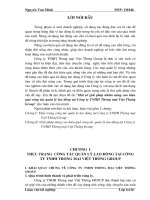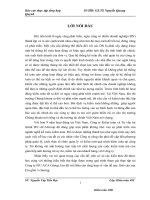group assingment apple
Bạn đang xem bản rút gọn của tài liệu. Xem và tải ngay bản đầy đủ của tài liệu tại đây (4.77 MB, 14 trang )
<span class="text_page_counter">Trang 1</span><div class="page_container" data-page="1">
<b> GROUP ASSINGMENTAPPLE</b>
<b>Lecturer: Trịnh Trọng Hùng </b>
<b>MKT1804 – Group 1</b>
Đào Nguyễn Khánh Linh - HS170521Vũ Cao Sơn - HS171396Lê Minh Hoàng - HS160742Nguyễn Thị Cẩm Ly – HS173141
Vũ Đình Long - HS170004
</div><span class="text_page_counter">Trang 2</span><div class="page_container" data-page="2"><i><b>I. Company description, mission, focus, structure...3</b></i>
<i><b>II. SituTation analysis...3</b></i>
<b>1.Company SWOT analysis:</b>... 3
<i><b>III. Marketing analysis...5</b></i>
<b>1.Market and target customer</b>... 5
<i><b>III. Overall marketing strategy ( the sales plan )...6</b></i>
<b>1.Product Strategy and description</b>... 6
</div><span class="text_page_counter">Trang 3</span><div class="page_container" data-page="3"><i><b>V. REFERENCS...13</b></i>
<b>1.Overview: </b>Apple is a very classy corporation in the field of technology in the US. Apple Corporationwas established on April 1 and has so far experienced 7 CEOs with 6 main product lines such as iPhone, iPod, Ipad, Macbook, Apple Watch, Apple TV
<b>2. Mission:Apple's mission is "Challenge the status quo, change the perspective of thinking". This is </b>
different from competitors in the market, Apple has never defined itself by what Apple does, instead defining itself by what others do.
<b>3. Focus:Apple has focused on creating premium products that deliver high-quality experiences to </b>
consumers. This focus on high-end products has allowed Apple to differentiate itself from other competitors. In addition, Apple also pays great attention to design and user interface, prioritizing aesthetics and simplicity in its products.
<b>4. Structure:Apple has a hierarchical organizational structure with a clear operating system. Headed </b>
by the CEO, followed by senior executives overseeing various areas of the company such as marketing, design and operations, and marketing. The company is also divided into specific product groups and has different responsibilities for developing product lines. This structure allows for efficient decision making, optimizing staff and product volume, and demonstrating that each product delivers high quality to the user.
<b>II.SITUTATION ANALYSIS</b>
<b>1.Company SWOT analysis:1.1 Strength:</b>
- Strong brand image: Apple has one of the most valuable and recognizable brands in the world, built on innovation, quality, design, and customer experience. This strong brand image contributes to customer loyalty and helps Apple maintain its market position.
- Retail presence: Apple has a strong retail presence through its Apple Stores, which provide a unique and personalized shopping experience. These stores contribute to the company's strong brand image and help build customer loyalty.
<b>1.2 Weakness:</b>
- Software limitations: Apple's proprietary software and operating systems can sometimes limit compatibility with third-party applications and accessories. This can make it challenging for users who need specific software or hardware that is not compatible with Apple's ecosystem.
- Dependence on the iPhone: Apple relies heavily on the iPhone for a large portion of its revenue, making the company vulnerable to fluctuations in the smartphone market.
- Incompatibility with other platforms: Apple's closed ecosystem can make it difficult for users to switch from other platforms or use non-Apple products and services, potentially limiting its market reach.
<b>1.3 Opportunities:</b>
</div><span class="text_page_counter">Trang 4</span><div class="page_container" data-page="4">Africa, where smartphone penetration is still relatively low and there is a growing middle class with increasing purchasing power.
- Expansion of services: Apple has the opportunity to further develop its range of services, such as Apple Music, Apple Pay, and iCloud, to generate more revenue and create a more comprehensive ecosystem forits users.
- Focus on sustainability: Apple can leverage its commitment to sustainability and environmental responsibility to differentiate itself from competitors and appeal to environmentally-conscious consumers.
the years, which can lead to significant legal costs and potential damages if the company is found to be inviolation of another company's patents or trademarks.
<b>2 . Product/Service SWOT analysis:2.1 Strength:</b>
- Product innovation and design: Apple is known for its innovative products, such as the iPhone, iPad, and MacBook. The company's focus on design and user experience sets it apart from competitors, making its products highly sought-after by consumers.
- Integrated ecosystem: Apple has developed a seamless ecosystem connecting its devices' hardware, software, and services. This integrated ecosystem creates a user-friendly experience and makes it difficultfor customers to switch to competing products.
- Efficient supply chain management: Apple's supply chain management is among the best in the world. This allows the company to quickly bring products to market while maintaining high quality standards.- High-quality products: Apple is known for its high-quality products, which are known for their
performance, design, and user experience. This has helped Apple to build a loyal customer base.
- Limited product portfolio: Compared to some competitors, Apple has a relatively limited product portfolio, mainly focusing on high-end products. This may limit the company's ability to capture a wider range of customers with varying needs and budgets.
- Incompatibility with other platforms: Apple's closed ecosystem can make it difficult for users to switch from other platforms or use non-Apple products and services, potentially limiting its market reach.
</div><span class="text_page_counter">Trang 5</span><div class="page_container" data-page="5">- Diversification of product offerings: Apple can diversify its product offerings by introducing new products in areas such as wearables, home automation, and automotive technology.
- Sustainability and environmental initiatives: Apple can differentiate itself from competitors by focusing on sustainability and environmental initiatives, such as using renewable energy sources in its manufacturing processes and developing products made from recycled materials.
<b>2.4 Threats:</b>
- Intellectual property theft and counterfeiting: Apple's products and designs are often targeted by counterfeiters and intellectual property thieves, which can damage the company's brand image and negatively impact sales.
- Intense competition: Apple faces intense competition in the technology industry from companies like Samsung, Huawei, and Google. These competitors may introduce new products and services that could potentially outpace Apple's offerings.
<b>III. MARKETING ANALYSIS</b>
<b>1. Market and target customer1.1 Market:</b>Apple's market is highly diverse and extensive, encompassing products and services such as iPhone, iPad, Mac, Apple Watch, AirPods, App Store, Apple Music, iCloud, and much more. These products and services all contribute significantly to Apple's revenue and profits.
The iPhone is Apple's flagship product and the company's primary revenue source. The iPhone accounted for 49% of Apple's revenue in Q3/2022. On the worldwide market, Apple's phone competes directly with big rivals like Samsung and Huawei.
Other popular items include Apple's iPad and MacBook. These products are all distinctive, tastefully designed, and high-performing, and are especially popular in industries such as education and the arts.In addition to hardware products, Apple also offers online services such as the App Store, Apple Music, and iCloud. These services are increasingly contributing to Apple's revenue. According to Q3/2022 revenue, Apple's services ranked second in revenue after the iPhone with 23.6% and are competing directly with rivals such as Google and Amazon.
Overall, Apple's market is very large and diverse, with notable products and services in many different areas.
<b>1.2 Target customer:</b>
Apple's target customers are typically those willing to pay a premium price for high-quality products that arebeautifully designed, easy to use, and provide a seamless user experience. Below are some of Apple's key target customer groups:
Tech-savvy customers: Apple targets people who love technology and want to own high-end and sophisticated tech products.
Stability and safety-demanding customers: Apple always ensures that its products are tightly designed, optimized for stability and security, to meet the needs of users who have high demands for stability and safety.
</div><span class="text_page_counter">Trang 6</span><div class="page_container" data-page="6">using advanced applications and technologies.
Work-oriented customers: Apple targets computer users who want to increase productivity and efficiency in their work.
Design-loving customers: Apple targets people who love high-end and luxurious designs, who want to own products with beautiful and refined designs.
<b>2.Differential/competitive advantage</b>
<b>2.1 Differential advantage</b>
Apple's exclusive operating system: The iPhone runs on Apple's exclusive iOS operating system, which is designed specifically for Apple's devices. This operating system is known for its user-friendly interface, stability, and security features.
Integration with the Apple ecosystem: The iPad, Apple Watch, and MacBook are all components of the Apple ecosystem, which also includes the iPhone. Users may easily transfer data and content between devices thanks to this connection.
High-quality hardware: Apple develops and produces its own hardware that is designed to integrate well with its software. The iPhone's hardware is renowned for its dependability and premium parts.App Store: With more than two million apps accessible, the App Store is the world's largest app marketplace. iPhone users have access to a variety of high-quality apps thanks to Apple's curation of the App Store, which makes sure that apps adhere to its quality and security requirements.
Powerful brand: With a reputation for innovation, quality, and design, Apple is among the most valuable brands in the world. The iPhone has a considerable competitive edge over rival cell phones thanks to its tremendous brand awareness and emotional connection with consumers.
<b>II.1Competitive advantage</b>
Strong Brand Image: One of the most well-known and valuable brands in the world is Apple. The firm has a devoted following of customers because of its strong brand image, which is founded on innovation, quality, design, and customer experience.
Product Design and Innovation: Apple is renowned for its cutting-edge goods, such as the iPhone, iPad, and MacBook, which have revolutionized the IT sector. The business has distinguished itself from rivals thanks to the user-friendly, sleek, and modern design of its products.
Ecosystem: Apple has built a streamlined ecosystem connecting its devices' hardware, software, and servicesthat make it simple for users to use and enjoy them. Because of this ecosystem's high switching costs, customers are less likely to move to a rival's product.
Supply Chain Management: Among the finest in the world is Apple's supply chain management. The corporation is able to swiftly launch items onto the market while maintaining high standards of quality because of the network of manufacturers and suppliers.
Retail Presence: Apple has a significant retail presence through its Apple Stores, which provide a unique andpersonalized buying experience. The stores are designed to highlight the company's products while also providing great customer service, which has contributed to the development of a strong brand image and client loyalty.
</div><span class="text_page_counter">Trang 7</span><div class="page_container" data-page="7"><b>1. Product Strategy and description1.1. Product strategy:</b>
Apple's product strategy is to offer high-quality, innovative, and user-friendly products that differentiate the company from its competitors. The company focuses on creating a seamless user experience by integrating its hardware and software.
Apple also prioritizes design in its product strategy, creating devices that are sleek, modern, and aesthetically pleasing. The company invests heavily in research and development to stay at the forefront of technology and bring new products to market.
<b>1.2 Product description:</b>
iPhone: The iPhone is Apple's flagship product and a global leader in the smartphone market. The iPhone offers advanced features such as facial recognition, high-quality cameras, and wireless charging. Apple releases a new iPhone model each year with upgraded features and design.
iPad: The iPad is a tablet computer designed for personal and professional use. The iPad offers a range of features such as a high-resolution display, touch screen, and support for Apple Pencil. The iPad comes in a variety of sizes and models to suit different needs.
Mac: The Mac is Apple's line of desktop and laptop computers. The Mac offers advanced features such as retina display, touch bar, and Apple-designed chips. Apple releases new Mac models periodically with upgraded features and design.
Apple Watch: The Apple Watch is a smartwatch designed for fitness tracking, communication, and entertainment. The Apple Watch offers features such as heart rate monitoring, GPS tracking, and cellular connectivity. Apple releases new Apple Watch models periodically with upgraded features and design.Apple TV: The Apple TV is a streaming device designed for entertainment. The Apple TV offers access to arange of streaming services such as Netflix, Hulu, and Apple TV+. The Apple TV comes with a Siri-enabledremote for easy navigation.
In addition to these products, Apple offers a range of accessories such as AirPods, Apple Pencil, and Magic Mouse. The company also offers a range of services such as Apple Music, Apple Pay, and iCloud. 3
</div><span class="text_page_counter">Trang 8</span><div class="page_container" data-page="8">Apple's pricing strategy is to set premium prices for its products that reflect their high quality, design, and features. The company does not compete on price with other companies in the market, instead, Apple focuses on differentiating its products based on their design, functionality, and brand reputation.In addition, Apple's pricing strategy includes product bundling and upselling to encourage customers to purchase multiple products or upgrade to higher-end models. For example, when customers purchase a new iPhone, Apple may offer a discount on other products such as AirPods or AppleCare+.
Apple's pricing strategy is also supported by its distribution channels. The company sells its products preeminently through its own branded retail stores and online store, where it can control the pricing and maintain a sense of exclusivity around its products.
<b>3.Promotion strategy:</b>
Apple's promotion strategy is one of the most successful in the tech industry. The company has a strong brand image that is built on innovation, quality, and design. Apple's promotion strategy includes a range of tactics that aim to create awareness, build brand loyalty, and generate demand for its products.
<b>3.1 Product Launch Events: </b>
Apple has built a reputation for its highly anticipated product launch events. These events are designed to create buzz and generate excitement around new products. Apple typically invites the press, industry insiders, and loyal customers to attend these events, which are often held at its headquarters in Cupertino, California.
iPhone 14 launch event
<b>3.2 Branding: </b>
Apple has a strong brand image and reputation that is built on quality, design, and user experience. The company's branding strategy is focused on creating a unique and memorable brand image that resonates withits customers.
</div><span class="text_page_counter">Trang 9</span><div class="page_container" data-page="9">is a key component of its brand image. Apple products are known for their sleek, minimalist designs that prioritize simplicity and functionality. And Apple also focuses on user experience, The company's products are designed to be intuitive and easy to use, which has helped create a loyal customer base.
<b>3.3 Advertising: </b>
Apple uses a variety of advertising methods to promote its products. The company's advertising campaigns are known for their creativity and emotional appeal. Apple often focuses on the user experience in its advertising, emphasizing the ease-of-use and intuitive design of its products.
"What happens on your iPhone, stays on your iPhone" is a marketing slogan that Apple used in a campaign to promote privacy and security features of its iPhone devices. The slogan is a play on the popular saying "What happens in Vegas, stays in Vegas," which is associated with the idea of keeping secrets and maintaining privacy.
</div><span class="text_page_counter">Trang 10</span><div class="page_container" data-page="10">privacy and security seriously, and that users can trust that their personal information and data will not be shared with third parties without their consent. Apple has implemented various security measures and privacy features on its devices, such as strong encryption and user control over data sharing, to ensure that user data is protected from hackers, cybercriminals, and government surveillance.
<b>3.4 Retail Stores:</b>
Apple has a network of retail stores around the world that are designed to provide a premium shopping experience. These stores feature sleek designs, friendly staff, and interactive displays that showcase Apple's products. Apple uses its stores as a key promotion tool, encouraging customers to try out its products and providing hands-on demonstrations.
1. Apple store
<b>4.Place/Distribution Strategy:</b>
Apple's Place/Distribution strategy is an essential component of its overall marketing strategy. The companyoperates in a highly competitive market, and its success depends on reaching its target market effectively. Here is an analysis of Apple's Place/Distribution strategy.
<b>4.1 Distribution channels:</b>
Apple has a unique distribution channel strategy that involves selling its products through its own retail stores, online stores, and authorized resellers. The company has over 500 retail stores in more than 25 countries, and its online store is available in over 39 countries. Apple also works with authorized resellers to distribute its products through their retail outlets. By having its distribution channels, Apple can maintain greater control over the customer experience and ensure that its products are displayed appropriately.
</div>








